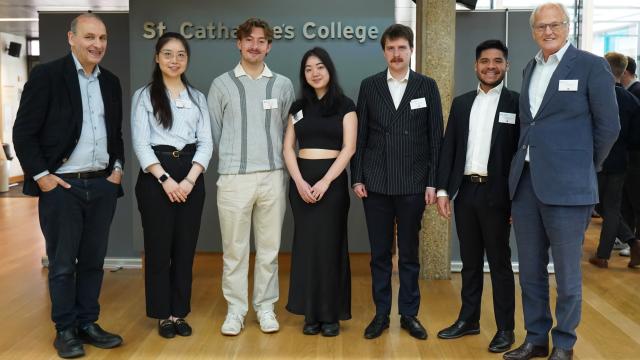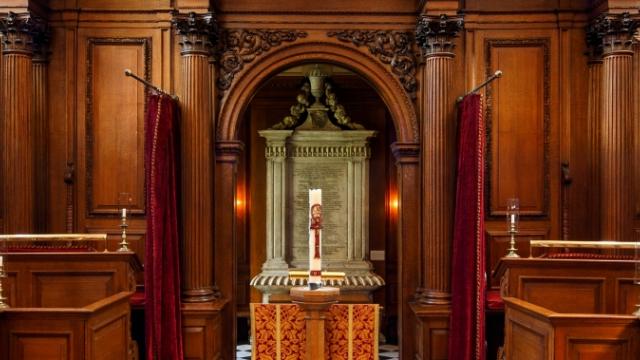
How sites deal with the silences and taboos surrounding difficult history matters. On a recent trip to Lithuania, St Catharine's Fellow Dr Gilly Carr (2006) and other members of the International Holocaust Remembrance Alliance (IHRA) Safeguarding Sites team learned more about this challenge, shared by so many Holocaust sites, and used this experience to inform their forthcoming heritage charter. This article first appeared on the IHRA website.
A series of nineteenth century forts surrounds the Lithuanian city of Kaunas. During the Second World War, several of these became sites of the Holocaust. In early July 1941, German Einsatzgruppen and their Lithuanian auxiliaries began systematic massacre of thousands of Jewish men, women, and children in the forts around Kovno, as it was known then, primarily in the Ninth Fort as well as in Forts Four and Seven. Estimates suggest that around 50,000 people were killed at the Ninth Fort during the Second World War – mostly Jews from the Kovno ghetto as well as Jews deported from Austria, Poland, France, the Soviet Union, and Germany. Among the victims were also numerous communists, Roma, and Soviet prisoners of war.
Today, 80 years after the Holocaust, the forts represent complicated pasts that are difficult to come to terms with. And like all others, these Holocaust sites face a variety of challenges.
The Safeguarding Sites team recently visited three of these forts – Forts Nine, Four and Seven – to gather further input for their forthcoming heritage charter, which aims to provide holistic guidance on the preservation of sites of the Holocaust and the genocide of the Roma. The absences, silences, and taboos they observed made them reflect on how these can impact the way countries deal with difficult histories. Realising that many, if not most, countries grapple with these issues, they updated their draft charter to include practical guidance in these areas.
The distortive potential of the unmarked and unsaid
Towering 32 metres over a now grassy field, the memorial at the Ninth Fort, unveiled in 1984, commemorates the approximately 50,000 people who were murdered there by the Nazis and their collaborators. Despite a number of memorial plaques lining the grassed area, many visitors appear to be unaware that this field marks a killing site and mass grave.
This apparent ambiguity means that people have also used Fort Nine as a backdrop for selfies, or as a place to go for a jog, walk their dogs, or fly drones. During their visit, the team saw someone, likely unknowingly, pushing a baby’s stroller over the location of the mass grave. Clearly marking areas of execution and burial at killing sites encourages respect for the dead – unclear markings can encourage quite the opposite. But markings are only one way sites can help present a fuller picture of this difficult history.
Insufficient information, like unclear markings, also contribute to silences, which provide opportunity to distort the history of the Holocaust. The director of the Ninth Fort, Marius Peciulis, understands this all too well, and is spearheading the remodelling of the Ninth Fort’s exhibitions, seeking to carefully address the gaps in information at the site.
One major concern relates to information on locals who collaborated with the Nazis in the killing of Jews, who also fought as partisans, and who have enjoyed a long history as known and named heroes, an issue not unique to Lithuania. Exposing their wartime crimes and reversing their hero status is not an easy task for those who manage museums. The Forts can help fill in important gaps, including on whether the Lithuanian perpetrators were from Kaunas or other cities, how many there were, their motive for killing Jews, and how the local population reacted to the massacres. Sites play an important role in helping societies broach difficult subjects such as these, and work against the temptation to distort this history.
“The silences and absences of crucial information for visitors mean that, while visitors can learn that something terrible happened here, they lack the full picture. Without this, they cannot fully learn from it,” Project Chair Dr Gilly Carr said.
|
|
|
Taking a realistic approach to safeguarding history
Holocaust sites are crucial to reversing the trend of rehabilitation and Holocaust distortion. Dealing openly and accurately with this difficult past is not an impossible task. The Safeguarding Sites team emphasises taking a pragmatic and realistic approach to addressing silences and lack of information. Even seemingly small changes can make a big difference.
The team has, for example, recommended the development of a Holocaust heritage trail for Kaunas, linking all nearby sites in chronological order to help visitors get a fuller picture of this history. Other recommendations involve tackling the silences in forthcoming exhibitions at the Ninth Forth, providing visitors and the local community with greater context on how the Holocaust unfolded in Lithuania. Such steps turn traces of the past into an important foundation for deeper and more honest engagement with history.
Learning from the silences
Each visit provides invaluable input for the forthcoming Safeguarding Sites charter. “All sites face challenges. Our aim is to produce a truly holistic heritage charter for Holocaust sites to help them address these,” Dr Carr explained. “And this means becoming familiar with sites with a wide range of challenges, and in different geographical and political areas. It’s like weaving a huge tapestry. Each visit and each conversation we have with site managers, local tour guides, political representatives, and communities provides us with another colourful thread.”
The Lithuania visit signalled to the team that their draft heritage charter should include guidance on addressing gaps and silences. It was, they came to realise, an issue they had come across before on a previous site visit. “Visiting one site improves our understanding of other sites,” Dr Carr said.
It also sharpened their understanding of the role sites will play in the future in countering distortion and safeguarding the record of the Holocaust and the genocide of the Roma. “In the future,” Dr Carr said, “when we can no longer depend on survivors to fill in the gaps, sites will bear a special responsibility to say what is left unsaid. Our duty today, as the guardians of these sites for our generation, is to make sure they are prepared to do so.”








